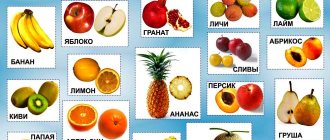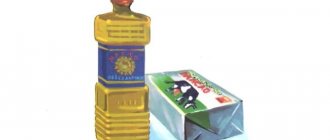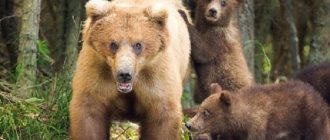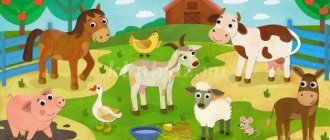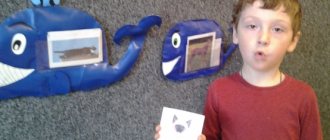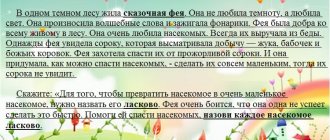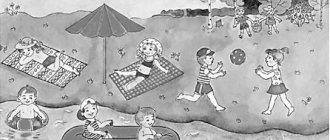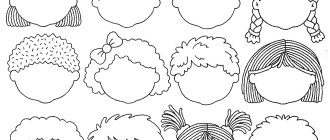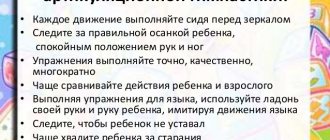General operating principles
If you want to get the maximum benefit from using visual material, then you need to follow several important rules:
- It is important to select images taking into account the age characteristics of the students. Children (up to 3 years old) need to be shown cards of domestic animals and birds only with those fauna inhabitants that the children can meet in person.
- The drawings should show real forest dwellers, animals of the seas and oceans, pets, and farm inhabitants. Avoid stylized images of wild animals and their domestic counterparts. The color of the coat and parts of the body should be natural, just like in nature. Not all children's pictures can be used in classes. For example, drawings of cartoon animals are completely inappropriate.
- It is important to choose images only with a light background, it does not distract attention.
- Cards with images should be attractive and durable enough. If you couldn’t buy good flashcards, you can glue the pictures onto cardboard yourself or laminate them.
Series of pictures “Domestic animals and their babies”:
Reading in warehouses “Wild Animals” according to Zaitsev’s method
Reading by folds differs from reading by syllables, since folds divide the word into more parts. For example, in terms of syllables, the word “crocodile” - kro-ko-dil - has 3 syllables. And for warehouses k-ro-ko-di-l - 5 warehouses. Dividing a word into words when teaching reading is very effective, which is why Zaitsev’s method has been very popular all over the world for many years, without losing its relevance and usefulness over the years for teaching preschoolers and primary schoolchildren.
You can download warehouse cards “WILD ANIMALS” in the attachments at the bottom of the page
Types of pictures
All cards for speech therapy classes can be divided into several groups.
Subject
Small cards, with one picture (an animal) on each. For example, in the series “Wild Animals of Our Forests” they will feature a wolf, an elk, and a badger.
“Animals of the North” set will consist of painted walruses, arctic foxes, and seals.
Plot
Illustration paintings with several characters and a plot. They help children write detailed, detailed stories using nouns, adjectives, and verbs. One plot picture allows you to discuss several topics at once: what benefits do pets bring, who cares for them, where they live.
brain teaser
A set of drawings depicting some kind of story, a plot in development. For example, some animals look different in winter and summer. An image of a squirrel in a gray and red coat, for example, allows a child to compose a story about the change of seasons and the preparation of animals for winter.
Drawings of wild animals and their cubs allow you to come up with a story about the childhood of a small animal.
Coloring pages
Outline images are another opportunity for the speech development of babies. High-quality coloring books help you master many new concepts and learn to use descriptive adjectives and prepositions. They also additionally stimulate the speech center (through regular fine motor skills training). Simple coloring pages can be used for children from 3 years old.
Coloring pages “Wild animals”
Didactic games for preschoolers on the topic: Animals
Didactic games for kindergarten on the topic: “Animals”
Author: Knis Anna Nikolaevna, senior teacher. Place of work: MBDOU “Kindergarten No. 3 “Smile”, Kalach - on - Don. Description of work : I bring to your attention didactic games for preschoolers on the topic: “Animals”. This material will help educators, children and their parents consolidate children’s knowledge about wild and domestic animals and their cubs in a playful way. Didactic game: lotto “Animals”.
Goal: To consolidate children’s knowledge about animals, the ability to distinguish and find the right animal. Didactic material: Game field (4 pcs.), divided into 6 squares with images of various animals, corresponding to the images on small cards (24 pcs.). Progress of the game: Game for children from 3 years old. The game can be played by 3-5 people. Players are given game cards. The presenter pulls out a small card from a special opaque bag, the player or the presenter names the animal. Whoever finds the corresponding image on his field takes the picture for himself. This continues until one of the participants covers the entire playing field with chips. For children over 5 years old, the game can be complicated. Name in one word the animals depicted on the same playing field. The first field shows: cat, pig, horse, cow, goat, sheep. These are pets. The second field depicts: deer, squirrel, elk, fox, wild boar, wolf. These are forest animals. The third field depicts: sloth, echidna, platypus, kiwi, iguana, koala. These are the animals of Australia. The fourth field depicts: lion, rhinoceros, giraffe, camel, elephant, zebra. These are the animals of Africa. Didactic game “Who lives where?” Goal: To develop children’s skills to correlate images of animals with their habitat. Didactic material: Cards with images of animals, 24 pieces (taken from lotto) and two playing fields with images of a forest and a village.
Progress of the game: Arrange the cards according to the habitats of animals, domestic ones in the village, and wild ones in the forest. Didactic game “Guess what kind of animal” Goal: Developing the ability to describe animals and recognize them by description. Didactic material: Cards with images of animals. Progress of the game: The teacher distributes cards with images of animals to the children. Children do not show their cards to anyone. The teacher invites one child to describe the animal depicted in his picture, or to make a riddle about it. Other children must guess what kind of animal it is. Didactic game “Collect a picture” Goal: Development of logical thinking, outlook, cognitive interest and speech activity. Didactic material: Cards with images of animals, cut into several parts. Progress of the game: Game for children from 3 years old. Children are given game cards cut into 2, 3, 4 parts (according to the age and abilities of the child). Having collected the picture, the child tells what animal he collected. For example: A dog is a pet. The bear is a wild animal. Didactic game “The fifth odd one” Purpose: Development of skills to classify animals according to essential characteristics. Didactic material: Cards with images of 5 animals, 4 of them belong to one thematic group, and the fifth to another group. Progress of the game: Children are given the task: “Look at the pictures, name what is depicted on them and determine which animal is the odd one out. Call the remaining animals in one word.” Each participant eliminates the extra animal in turn. If he makes a mistake or does not complete the task, his version is offered to the next player to complete. For each correctly completed task they give a chip. The one who collects the most chips wins. Cards for the game: 1.Cat, fox, squirrel, wolf, bear. The extra porridge is because it is a domestic animal and the rest are wild animals.
2.Deer, tiger, dog, fox, lion. The extra dog is because it is a domestic animal and the rest are wild animals.
3. Pig, sheep, dog, fox, cat. The extra fox is because it is a wild animal and the rest are domestic animals.
4.Horse, zebra, cow, donkey, goat. The extra zebra is because it is a wild animal and the rest are domestic animals.
Didactic game “Whose Tail” Purpose: Development of attention, logic, memory, fine motor skills. Didactic material: Cards with images of various animals, as well as their tails. Progress of the game: The child is given a task. Choose a tail for each animal and connect the necessary pictures with lines. Name which animal has which tail (long, short, fluffy, thick, small, large, etc.).
Didactic game “Whose baby” Purpose: Development of observation, attention and analytical abilities. Didactic material: Cards with images of baby animals, 12 pieces and two playing fields with images of wild and domestic animals. Progress of the game: The guys have to help mothers find their babies. Also, when playing, you can reinforce the concept of big and small, domestic and wild animals in children. The game can be played by one to four people. Didactic game “Whose Shadow” Purpose: Development of logic, thinking and visual memory. Didactic material: Cards with images of various animals, as well as their shadows. Progress of the game: Invite the child to find where whose shadow is and connect the necessary pictures with lines.
Didactic game “What animals are hidden in the picture?” Goal: Development of attention, thinking, imagination. Didactic material: Cards depicting the outline of various animals. Progress of the game: Invite the child to find and name the animals drawn in the picture.
We recommend watching:
Didactic games with sand for children 3-4-5 years old Conversation for preschool children (4-6 years old) about animals Summary of a lesson on speech development and familiarization with the environment in the senior group Project for children of the senior group on the topic “Fauna and flora of the native the edges"
Similar articles:
Poems about pets for children 5-6 years old
Coloring pages “Wild animals” for children 5-7 years old
About the beaver for children 6-7 years old
A story about a monkey for children 6-7 years old
About possum for children
Educational games with cards
Following Maria Montessori's method, you need to use as much visual material as possible that the baby can pick up and play with. Such games help children improve fine motor skills, develop tactile receptors, and memorize better.
To get acquainted with the kingdom of animals, we suggest using paper pictures of animals.
- You can use purchased pictures of animals, or you can download images of animals from this site.
- After printing the downloaded photos on a printer, glue them onto a sheet of cardboard and cut them into cards.
- If desired, the cards can be laminated or covered with tape.
These cards will be used during the game for the development of children.
We shuffle the cards and ask them to group them, naming the animals correctly. Knowing the names of animals makes a child’s speech more literate, expands his vocabulary and will certainly serve him well when entering school. At the end of the lesson, we draw the animals we like the most with the children. We will organize an exhibition of drawings.
Pets
For children starting to learn, images with pets are perfect. Their charming faces, beautiful paws and tails, fluffy fur and funny habits will delight and amuse any child. Here you can find for free many great pictures of pets, specially selected for the development and entertainment of kids.
Naturally, you should start viewing materials about animals that have been domesticated by humans with a short introduction. Tell your child that some animals have been “friends” with humans for a long time, protect them, guard farms, give milk, catch mice: dogs, cats, cows, horses. If you have a pet at home, ask your child to find it in the picture to understand that he is learning the material well.
Dog
Cat
Horse
Cow
Lamb
Bull
To make the lesson even more fun, you can download our photos of animals for children or drawing diagrams to your phone or work computer and print them. However, you can see drawn and photographed, real and cartoon, big and small animals from a laptop monitor. You can see a complete list of all color images, videos and riddles on the "Pictures of Pets" page.
Forest animals pictures for children
Bear
The bear is a large animal; it is considered one of the symbols of Russia.
Bear.
The brown bear is a forest-dwelling forest animal. Very often this animal can be found in Kamchatka. The brown bear is a fairly large animal; the maximum recorded weight of a male bear caught in Kamchatka was more than 600 kg.
See also: Development of fine motor skills
A mother bear with cubs.
The brown bear can eat both plant foods and hunt other animals. More than half of his diet consists of plant foods: various berries, nuts, roots, and so on. Since the bear is clumsy and cannot run fast, it rarely manages to catch a deer or roe deer. But such a giant can eat insects and their larvae, catch fish, lizards
In winter, bears hibernate until spring. To do this, they equip dens in pits or caves.
Wolf
The wolf is a beautiful predator, similar in appearance and size to the German Shepherd. Wolves are pack predators; with their devotion to the pack they can set an example for people.
Wolf.
The wolf's main prey is large ungulates. A pack of wolves chases down a weak deer; a strong pack can even attack an elk weighing about half a ton. The leader starts the meal first, only after him does the rest eat.
Wolves howl.
Fox
The fox has the reputation of being a very cunning animal.
Fox.
Foxes are small animals. An adult fox weighs no more than 10 kilograms. They feed on small rodents, so they can often be found near human settlements, where there are more rodents.
But not only rodents make up her diet, she can hunt small birds, try to catch a hare, but this is difficult for her to do, since hares are faster than foxes. When hunting, a fox often uses cunning; for example, it can pretend to be sleeping near a flock of partridges, and when the birds lose their vigilance, it can suddenly attack.
The fox is a very curious creature. She is interested in everything new and unusual, and this often becomes the cause of problems. For example, a fox can fall into a hunter's trap.
Boar
Boar are wild pigs. Boars are quite large animals; the weight of an adult boar can reach 250 kilograms. With such a mass, they can run at speeds of up to 40 km/h.
Boar.
Wild boars feed on everything they find in the ground. These can be various roots, worms and insect larvae, fallen fruits, acorns, chestnuts, and so on. A boar can eat a lizard or toad if it catches one.
Wild boar piglets.
If a boar feels threatened, it becomes very dangerous. His fangs can reach 20 centimeters in length, and he does not hesitate to use them.
In search of food, the wild boar performs the function of a tiller; it loosens the ground and plant seeds fall deeper, and their chance of germination increases.
Hare
The hare is a small herbivore that is generally considered cowardly. But this is fundamentally wrong; once in the clutches of a predator, the hare fights off with its strong hind legs. On these paws, moreover, he has large claws, with which he can inflict serious injuries on his attacker, or even kill him.
Hare.
But hares avoid fights with predators, and they have only one way to do this - quickly run away. They are capable of reaching speeds of up to 75 km/h if their lives are in danger. Who doesn't try to hunt hares! The fox poses a danger to young hares; it cannot keep up with adults. Wolves often prey on older hares. Lynxes and large eagles, ermines, wolverines and martens can attack hares.
Hare with a bunny.
Wolverine
Wolverine is a predatory animal in the northern forests of Russia. The wolverine is a relative of martens, although in appearance it resembles a bear.
Wolverine.
The weight of a wolverine can reach 30 kilograms. Females are slightly smaller than males, but this is where their external differences end.
It is believed that the basis of the wolverine's diet consists of carrion, which it picks up from bears and wolves. In addition, the wolverine hunts everything it can catch. It is a great success for a wolverine to catch a wounded and weakened small deer.
Pictures of sea animals
We all go to the sea with our children and often go to dolphinariums and oceanariums, where we can get a closer look at the world of marine animals. But sometimes it is difficult for a child to remember what a particular sea creature looks like. Colored pictures of sea animals will be useful to show your baby.
Turtle
Starfish
baby walrus
Dolphin
Octopus
Shark
Som
Catfish are a real predator, and not a scavenger, as is commonly believed. One of the largest freshwater fish in Russia, which is common in many reservoirs.
Som.
Catfish can hunt not only fish and crayfish. It can also attack birds, for example, here is a video of how a catfish hunts pigeons.
Catfish in the Dnieper River.
Typically, catfish reach a mass of 20 kilograms with a length of 1.5 meters. But under favorable conditions, catfish can grow to the size of real giants and weigh 400 kilograms with a length of up to five meters. This is just a monstrous fish!
Zander
Pike perch is another predatory freshwater fish, widespread in the European part of Russia. It lives only in flowing reservoirs, the water of which is rich in oxygen.
Pike perch under water.
Pike perch can grow up to 120-130 centimeters, while its weight can reach up to 18 kg.
See also: Painting with watercolors
Pike perch is a very aggressive predator, but the diameter of its throat is small, so it does not attack large fish, as catfish and pike do. Its prey: bleaks, small ruffs, and so on.
crucian carp
Crucian carp is a very cautious fish. Crucians are practically omnivorous and survive well in the most difficult conditions.
crucian carp
There are two types of crucian carp in Russia: golden and silver.
Beluga
Beluga is the largest freshwater fish; it can grow more than four meters in length and weigh more than one and a half tons.
Beluga.
Belugas live most of their lives in the waters of the Azov, Black and Caspian seas. Belugas enter rivers only during the breeding season.
Belugas lead a solitary lifestyle. During the winter, they hibernate, before which their body is covered with a thick layer of mucus, which acts as warm clothing.
The main food of belugas is small fish, such as gobies and a variety of carp, herring and other similar fish.
Syllables for reading – Cards with pictures – Download and print
Before starting classes, ask if your child knows well which of the 12 animals are domestic and which are wild, where these animals live and what they eat. If you have already downloaded syllables for reading - cards with birds, mix a few pictures with birds with the animals and see if the child pays attention to it. Having previously cut the cards into pieces, ask the child to assemble each animal from these parts.
Start learning to read using cards, initially choosing pictures in which the names of animals are assembled from simple syllables consisting of only two sounds, gradually moving on to studying more complex ones, including hissing and voiceless consonants. When pronouncing how a particular syllable is read correctly, draw the child’s attention to its writing by running your finger over the syllable - this is necessary in order to simultaneously engage the baby’s visual and auditory perception.
Here you will find syllables for reading - Cards with the following animal names: squirrel, hippopotamus, hare, zebra, cow, kitten, crocodile, rhinoceros, fox, sheep, dog, turtle.
At the initial stage of learning, carefully monitor whether the child correctly repeats the pronunciation of syllables after you, correct if you hear that the child is making mistakes in order to prevent the formation of an erroneous understanding of sounds and syllables. Gradually complicate the tasks by giving all kinds of your own examples, or downloading additional cards with pictures and syllables.
You can download syllables for reading - Cards with animal names in pictures in the attachments at the bottom of the page
Always remember that your child should not be bored while learning: try to diversify your activities as much as possible, supplementing them with games, funny tasks, reading poetry, and mathematical calculations.
Reading by syllables “Animals”:
Pictures of birds
A developed baby should be able to distinguish between the main types of birds. We offer you good images of these kind feathered representatives of nature, as well as their drawings and cartoon pictures. Some of them will serve an educational purpose (especially in combination with riddles and rhymes), while some may make the child laugh to tears and lift his spirits.
Sparrow
Owl
Parrot
Magpie
So, if you are looking for pictures of birds that are easy to understand and understandable for kids, thanks to which he will learn to distinguish them and identify their tracks, then you are on the right site. The whole family can use these materials: they will be interesting for both boys and girls. To show your child all the images, videos and riddles, visit the “Bird Pictures” section.
Bullfinch
Bullfinch are birds slightly larger than a sparrow, the males of which are painted bright red. Female bullfinches are not at all brightly colored.
Bullfinch in winter
Bullfinch in May
The diet of bullfinches consists mainly of seeds and buds of trees and shrubs; bullfinches especially love rowan and bird cherry. Bullfinches can also eat small insects; they mainly manage to catch spiders.
Bullfinches: male and female
In winter, bullfinches do not fly anywhere, but spend the winter in Russia. If the winter is very cold and there is little food, then many bullfinches die. Under favorable conditions, the bullfinch can live up to 15 years.
Tit
The tit is a bird the size of a sparrow. It is distinguished by a yellow breast and a blue tint on the back.
In the warm season, tits prefer to feed on insects; at this time they are real predators. But in winter they are forced to switch to plant foods.
Tits on a sunflower
With the onset of cold weather, tits move to cities, as it is easier for them to find food here. In the spring they fly back to the forests.
Cuckoo
The cuckoo is a bird that is famous for two things: its “cuckoo” calls and the fact that it throws its eggs into the nests of other birds. Cuckoos do not build nests themselves and do not hatch their chicks; they parasitize other birds.
Cuckoo.
The body length of an adult cuckoo is just over 30 cm and weighs 190 grams; the maximum wingspan of the cuckoo reaches 65 centimeters.
Cuckoo with prey.
Cuckoos are migratory birds and for the winter they migrate to Africa and the tropical latitudes of Asia.
A cuckoo chick in a pipit's nest.
Woodpecker
The woodpecker is famous for chiseling trees with its beak in search of insects and their larvae. The knock from its “work” can be heard a hundred meters away.
Woodpecker.
Like tits, woodpeckers' diet depends on the time of year. In the warm season, they eat more insects, although they can destroy the nests of small birds by eating eggs and chicks. In winter, woodpeckers switch to plant food.
The woodpecker's tongue is visible in the photo.
Instead of making nests on branches, woodpeckers hollow out hollows in trees with soft wood (alder or larch, for example). This work is done mainly by the male and takes about two weeks.
The lifespan of a woodpecker very rarely exceeds nine years.
Pictures “Animals” for children
Gavrilov Pavel Leonidovich June 6, 2021 20:24
============A============= It soars over the ocean, It can circle for days, Even a storm with a hurricane This bird is not afraid! Who is this, the question came up? Well, of course, ALBATROSS! ============B============= Not such a simpleton This bull is a big guy. He is big and very strong, and horned, by the way. And his name is BISON, there is no reason to butt heads with him! ============В============= People run to escape from him, He doesn’t want to know anyone, Howls at the moon at night, Bares his teeth, plots intrigues... Hide, squirrels and bunnies, the WOLF will play hide and seek with you... ============G============== He is not a lion, not a leopard, But in fact It's a cat... But it's a hundred times faster. Its legs are faster. Running is his strong point and – start! This is what CHEETAH is famous for. ============D============ Not an echidna or a hedgehog, Multiply the size three times... He is just as “touchy”, It’s better for you not to touch him. A piece of Porcupine needles will immediately be left on your hands. ============E============ This young lady is prickly like a hedgehog, She has two pairs of legs like a hedgehog, But he is not at all suitable for a bride... She loves him very much rummage in the anthill. She’s not at all ashamed that she has no teeth... ECHIDNA wouldn’t be such a viper! ============Ё============== Small fish With a comb on the back - A cat grabs it with its claws, And the ruff, alas, is in the picture. Lucky fish - Outwitted the cat! ============F============= Fat, nasty, Found in swamps, Uncharismatic, But thinks she’s a fashionista... All day long she shows off on the edge of a pothole And cackles, sulking... What a TOAD! ============З============= Either the fox scolds him, Then he is not nice to the gray one, What prevents them from becoming friends, Why didn’t the scythe please him? And the answer is already clear - a BUNNY is not a friend for a couple! ============And============= He is beautiful and well tailored, Important! With branches-horns. And among the deer there is a warrior, Walking in circles in the meadow. The Manchurian Man is waiting for an opponent... Whoever pushes him out of the circle will become the main one in the herd - the Leader, my dear friend! =============K ============= Who lives in a chicken coop, lays good eggs and cackles endlessly? This is our CHICKEN! This, in fact, is not new - Milk is good for us! And the COW gives it, and not your kitchen tap... Drink, children, for your health Only fresh, cow stuff! =============L============= Sometimes there are nests on the windows, Her flight is swift, All her movements are fast, Her tail is fork-shaped, her wings are sharp... For It's May through the window... Spring is coming! We are waiting for the SWALLOWS to arrive! =============M============= Nice little brave man - Agile, just great! He is not afraid of rattlesnakes and is ready to fight anyone - A huge plus for him... His friend's name is MONGOOSE. =============Н============= He is in the family of monkeys He wears a small flaw - His big awkward nose - As if a banana had grown there. But NOSACH is happy with his nose... The rest is in question?! =============O============= He can be very stubborn, He will get up and won’t budge. This is a DONKEY, by the way, Sadness lives next to him. Apparently, it’s not sweet for the donkey, That he was not born as a horse. =============P============= Like a bright picture - A PEACOCK has a rainbow tail. Either he will trample imposingly, or he will walk importantly through the garden. He will surprise you from all sides with his complicated clothes. =============Р============= CANCER walks along the bottom of the sea, Crayfish saw its prey and received such a gift. From the bottom of my heart I am incredibly happy. He's ready to catch her! Start, throw... Grab with a claw! =============С============= Someone can’t sleep at night in the forest, Who sees how it is during the day even on dark nights, Who protects the animals’ sleep and birds - Bunnies, crows, sparrows, foxes... It’s easy to recognize her by her signs - it’s an OWL, kids! Are you satisfied with the answer? =============T============= It is reputed to be cautious, In the summer it lurks in the bushes, And in the winter, this rare bird lives under the snow. But just then, I’m ready to “sneak away”, Taking off casually. This is Black Grouse, kids, read books about him. =============U============= Who is the one with the duck nose, are you familiar with the platypus? He's pretty cute and a pretty decent swimmer. Lives by the pond, Digs holes without difficulty For housing and for offspring, Builds where there is more sun! =============F============ On the ground, I’ll say it seriously, Clumsy - neither this way nor that... But he flies masterfully, He’s a master at robberies; Taking the spoils from others has become a habit for him. Here's a sea pirate with a pink breast FRIGATE! =============Х============= Its color changes to match Many times a CHAMELEON, He has pinwheel eyes... From the tail to the top of the head, he will notice everything around , And at the same time, a mosquito... It will lick off the sticky tongue - What an accident! =============C============= She is from those places where it is very hot - She lives in distant Africa. Like chickens, the GUINEA FAR lays a domestic egg. And the boobies love to cackle, They are kindred spirits, after all. =============Ч============= Everyone knows this bird - I’ve seen it once, or even twice... Who circles under the blue sky And makes friends with the sea wave ? Come on, memory, help me out... You guessed it - it's a SEAGULL! =============Ш============= This folded little dog is a very nice cute dog! Like a soft toy And such a handsome guy, darling... Let me snuggle up to you, SHARPEIKA Let me cuddle a little. =============Ш============= He is the size of a sparrow (He is almost related to him), But the little one sings brighter, His clothes are more beautiful. Call the forest bird GORGIN For a colorful shirt! =============E============== The Airedale Terrier dog has a pleasant premiere - Even if there are only six lines, But there is a piece about him. He is happy about such a thing - At least briefly, but in moderation! =============I============== JAGUAR is a big pussy, Be careful not to come close, Get out of his way, This cat is very strict. He has a grip of steel... Know, kids, for order Pavel-Gavroche
